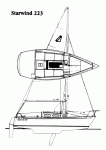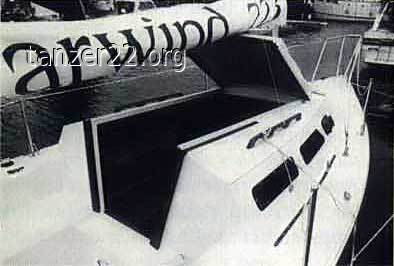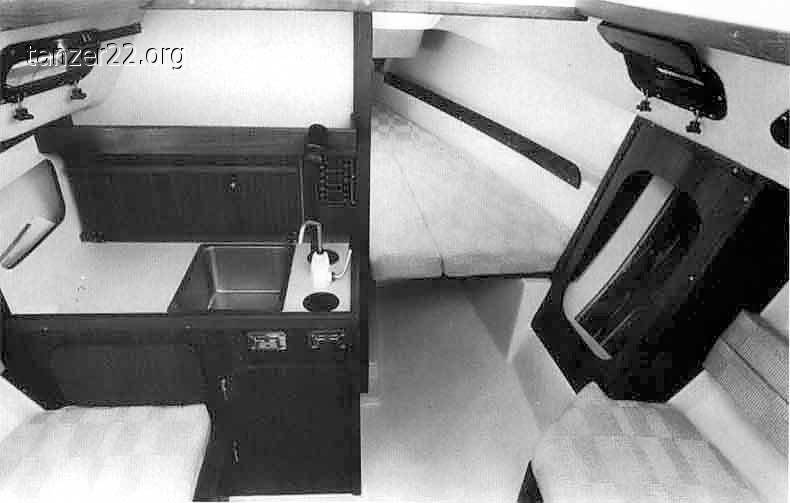
Drawn by Cortland Steck for Wellcraft Marine (the powerboat manufacturer)
and now built by Rebel Industries, this is a deceptively significant
design. With its 8½-foot beam, the 223 was one of the first trailerable
cruisers to take full advantage of recently revised highway regulations.
Its relatively large cockpit, crisp lines, forgiving performance, and
simple interior layout encompass the latest thinking of those designing
small sailboats.
Belowdecks, the 223's generous beam is evident. Steck opted for an open
design with a welcome lack of the "dollhouse" furniture that looks so
fine in drawings and is so unusable in real life. The 7-foot-9-inch
settee/quarterberths extend well into the cabin and should prove
satisfactory for all but the most claustrophobic. Placing the wood-bottomed
after cushions between the settees forms a 6-foot-6-inch-by-4-foot-4-inch
double athwartships berth. It is one of the largest we've seen on a
trailerable 22-footer -- and its location amidships means an easy motion at
anchor. This cozy arrangement completely disrupts traffic flow between the
cockpit and the head (located under the vee-berth), but no doubt the berth
will get considerable use when the boat is drawn up into secluded
coves.
The price exacted for the 223's large main cabin and 7-foot cockpit is a
tight vee-berth forward, adequate for two children or one adult. Unlike
many small boats advertised to "sleep four," the 223 has the rare virtue
of being very comfortable for a couple. Too often, when a couple sail a
small four-berth cruiser, they must sleep in marginal berths and squeeze
into tiny dinettes -- which cannot easily be modified because of the almost
universal use of drop-in molds (they speed up production). The Starwind's
open "honeymoon" accommodations offer a welcome change to that kind of
thinking.
The simple interior finish is typical of this class of boats. The cabin
gives the impression of containing considerable joiner work, but there's
really very little of the oiled teak that requires cut-and-try fitting.
It's a pleasant illusion. Abaft the port bulkhead, Steck placed a small
galley area with sink and with storage below. The nifty chart table folds
down over the countertop. The open hanging locker to starboard is lined
with cedar. Touch it lightly with sandpaper once in a while, and when you
close your eyes, you might forget you're aboard a fiberglass boat.
Carpeting lines the cabin ceiling, a pleasant contrast to slick gelcoat
headliners.
As might be expected from a boat built in Florida to plans drawn by a
Floridian, the 223's ventilation is superb. The companionway and forward
hatches are little short of gigantic. The companionway hatch cover flips up
and forward against the mast giving unlimited headroom in most of the main
cabin.
Getting around on the Starwind's deck is relatively easy. Although the
toerails are just meager bumps in the deck, the lifeline stanchions are
unusually strong for this type of boat. Reinforcing bails of heavy
stainless steel rod extend up from the bases and wrap around the stainless
stanchions. A transom-mounted swim ladder folds up to the stern pulpit. The
side decks are wide and the molded-in sand nonskid pattern offers good
traction without rasping the soles off your topsiders. Deck hardware is
backed up with 1/4-inch aluminum plate glassed into the laminate. Rising
from inboard chainplates, the shrouds interfere with a trip forward (as
they do on most boats we tested). Contemporary thinking seems to dictate
that tighter sheeting angles and better windward performance are worth the
inconvenience. A self draining anchor locker in the forepeak keeps one
messy piece of hardware out of the cockpit lockers.
The Starwind is laid up by hand (no chopped strand) with mat, roving, and
Coremat in amounts sufficient to please our meticulous boatbuilder-judge.
We saw no roving "print-through." The hull is smooth and fair, and the
tooling would be a credit to a more expensive boat. All fiberglass surfaces
seem appropriately stiff.
We appreciated the 223's traditional keel/centerboard. Its trunk doesn't
intrude into the cabin, and because the ballast is in the keel, the
unballasted board raises easily and does not produce wild changes in the
boat's stability. You really can sail this boat in shoal water.
Under sail, the 223 is predictable, if unexceptional, on all points. Even
with the board retracted (the pennant is right at hand in the cockpit), the
boat fights to stay on its feet and her helm exhibits no bad manners. The
well-made sails and the moderate aspect ratio rig are forgiving of
inattention; sail controls are basic and straightforward, but experienced
sailors might want to invest in a traveller or boom vang.
|
Open & Airy. The Starwind's flip-up companionway slide (top) insures maximum ventilation. Cabin furnishings are compact and unobtrusive (below)
|

|
|

|

|



